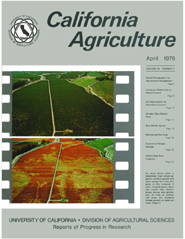Calag Archive
Calag Archive

Cover:
An aerial photo taken in September (top) shows apparent uniform growth and color except for a few thin spots in the vineyard. A color infrared photo taken six months later (below) shows drying and defoliation of vines on shallow soil areas, but excessive foliag growth on deep soil areas.
April 1976
Volume 30, Number 4
Volume 30, Number 4


